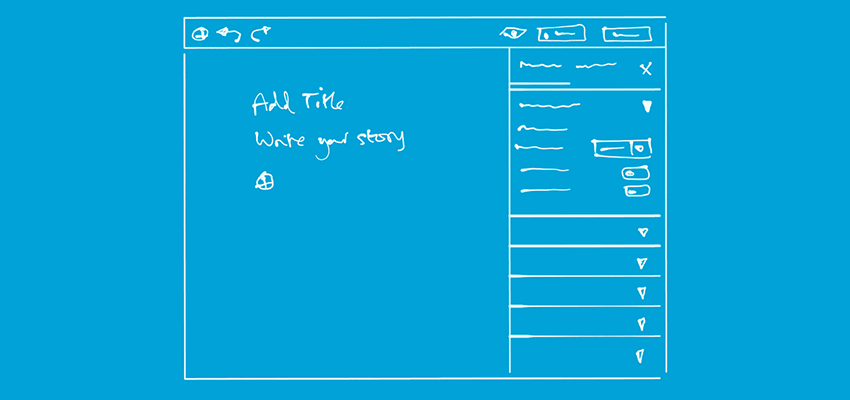As the importance of the web has grown over the past couple of decades, so have the responsibilities of web designers. It used to be that we had relatively little to worry about, save for making sure our creations looked good and worked properly. But those days appear to be just a distant memory.
These days, it seems like our worry list has grown exponentially. From major software upgrades to privacy battles – we’re in the thick of it. While designers aren’t always directly involved in these issues, we certainly are affected by them in one way or another.
Let’s take a look at the five biggest issues (in no particular order) that give us a case of the night sweats.
1. The WordPress Gutenberg Editor
I’ve written extensively about Gutenberg, which is slated to be released as part of WordPress 5.0. It’s generated a lot of buzz and a whole lot of debate in the developer community. And with WordPress powering about 30% of all websites, it’s going to have an effect on a whole lot of website owners and web professionals.
There is some understandable panic about what this completely new editing experience will do to existing websites. The paranoid thoughts range from custom sites breaking, to non-technical users being a bit dumbfounded when they login one day to see the editor completely changed. Some people I know are going so far as vowing to install the “Classic” Editor plugin the moment 5.0 is released.
I can certainly understand the trepidation many have about this change. History has shown us that any software upgrade can have unintended consequences. And many of us have dealt with a WordPress upgrade where something went wrong. Usually it’s because a plugin or theme is no longer fully compatible with the WordPress core (or each other).
In this area, we do have some things to worry about. There will be some old plugins that won’t be Gutenberg-friendly and never will. But WordPress also has a great history of backwards compatibility overall. The hope is that the problems are kept to a minimum and that any plugins that don’t make the cut can be easily replaced.
Yes, there is a lot to be concerned about. But in a lot of ways this is an exciting opportunity: One where content creators have a tool that makes life easier while designers can even use it to boost business. But still, it’s a big change we’ll have to deal with.

2. GDPR
The EU General Data Protection Regulation (GDPR) goes into effect on May 25, 2018. The law essentially says that website users have a right to know how a particular site collects data, what it collects and what it does with said information. It also gives EU citizens the right to have their data removed from a website upon their request. Plus, there are some guidelines for informing users of any data breeches.
GDPR will affect not only EU-based sites – but any site that has visitors from the EU. This means that sites worldwide are bound to comply, lest they risk a potentially massive fine.
As a user of many websites myself, I applaud the regulation. Privacy is incredibly important. But as a web designer who mostly works on websites based in the US, I am utterly confused as to what I’m supposed to do here. If an EU citizen files a complaint about my website – am I going to get fined? As a small business working with other small businesses – what responsibilities do I have?
The regulation puts web professionals in an awkward position – especially if we use third-party software and hosting (it could come down to the data practices of each individual WordPress plugin we install, for example). This is a bit of a mess for an industry that generally (in the US, anyway) hasn’t had to deal with many regulations.
Some clients may expect us to provide guidance on the issue. My advice here is to advise clients to speak to a legal professional. I know I’m not qualified to give legal advice and I don’t want any responsibility for the consequences of saying the wrong thing.
I have had a few people ask me about GDPR, and it’s something I want to cover more in-depth in the near future (with the help of an expert, preferably).

3. Ever-Growing Security Threats
Security is a subject that seems to only grow in size and scope. Whether it’s another massive hack of a big company or the impending end of TLS 1.0, there is no shortage of things that web designers have to think about.
Attacks on sites are getting more sophisticated as well. For instance, the rash of popular WordPress plugins that were purchased and weaponized by a nefarious soul that occurred in 2017 could well be a harbinger of things to come. When something we already use and trust suddenly starts doing harm – we may not realize what’s going on until it’s too late.
If it’s your job to deal with security, you’re probably pulling out your hair by now (I’m right there with you). It’s gotten to the point where I’ve installed security plugins that email me about a constant stream of threats and outdated software. It’s akin to watching bad news 24/7 – you’re left feeling a bit hopeless.
True, web designers shouldn’t necessarily be required to also be the head of security. But it does often fall on us to put measures in place. As long as that’s the case, security is one more thing we have to worry about.

4. Building Accessible Websites (and Retrofitting Old Ones)
Accessibility is another important issue that affects all of us. And it’s another challenge that web designers must meet. When building a website, the site not only has to look good enough to please your client. It also needs features that ensure anyone can get the information they need.
In some aspects, this dovetails with the aforementioned GDPR in terms of legal compliance. Both are legally complicated issues that require some heavy research. In the case of accessibility, there are established best practices but laws vary greatly from one part of the world to another. Some jurisdictions also have laws that are either outdated or vague (often both).
The good news is that, if you follow those best practices and do some testing, you’ll most likely come out with a good result. But think about a site designed a few years ago. Maybe there’s not enough budget to fully redesign it. That may require some retrofitting – which can be a difficult process.
This is an area where designers can really make a positive difference in the world – but it requires knowledge, skill and clients who understand the importance of making the web accessible to everyone.

5. Catering to the Whims of Big Data
Increasingly, the direction of the web is being heavily influenced by a few large entities. Some are governmental, like when the US Federal Communications Commission (FCC) recently voted to abolish net neutrality. But some governmental influence is to be expected – good or bad.
We also see a whole lot of influence coming from the corporate sector. The likes of Google, Amazon and Facebook are all making their presence felt in different ways.
For example, with Google’s Chrome browser planning to mark any unencrypted page as “Not Secure”, they are clearly wielding their influence. While this particular example is positive in terms of increasing the prevalence of SSL, it also shows that they can move the web in just about any direction they want – and we’re expected to comply with it.
And just so that I don’t single out Google, Facebook has caused plenty of stirs of its own. A recent change in its React.js license wreaked havoc on plans for the aforementioned WordPress Gutenberg editor. Fortunately, things calmed down and both parties are getting along.
But keeping tabs on how the wind is blowing with these entities has become a part of a web designer’s job. If we don’t stay informed, it means that we risk building sites that trigger browser warnings or don’t perform well in search engines. Am I the only one here who needs a nap?

The Job Description Has Changed
Indeed, web designers have a lot more on their plates than just making things look pretty. In the present, we must think of things like security, accessibility, regulatory changes and major changes to software. If that weren’t enough, we also have to deal with the fallout of whatever decisions the powers-that-be have made.
What does the future hold? I’m not sure my receding hairline can handle it.
Related Topics
Top